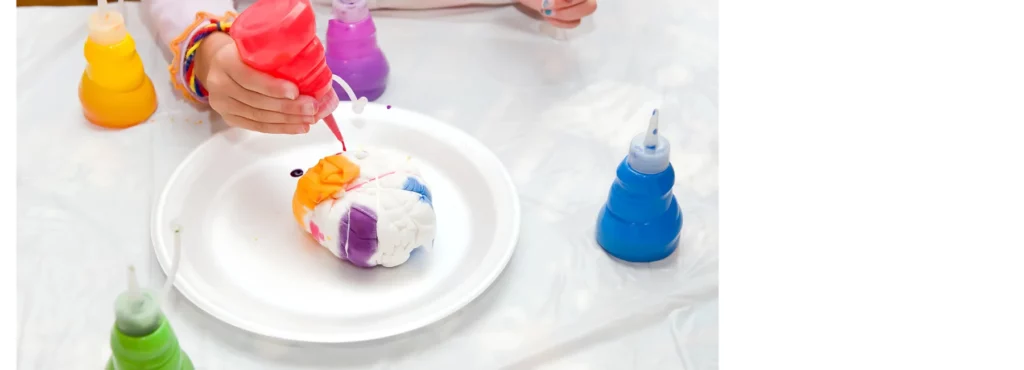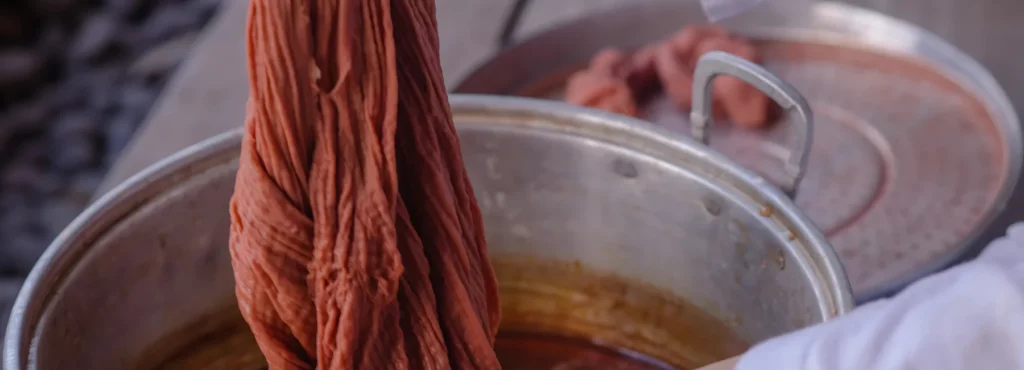Fabric Dye Basics
Fabric dyeing is an art form that can breathe new life into old garments. Whether you’re a seasoned artist or just starting your colour-filled journey, understanding the basics is key. Let’s dive into the exciting world of cotton vs. polyester dyeing properties and the intriguing role of colour psychology in fabric dyeing.
Cotton vs. Polyester Dyeing Properties
When it comes to fabric dyeing, cotton and polyester are two of the most commonly used materials. However, their reactions to dyes are as different as night and day. This boils down to their attraction to water, also known as their hydrophilic (water-loving) or hydrophobic (water-hating) nature.
- Cotton: Cotton fibres have a strong affinity for water. This means they soak up dye like a sponge, resulting in vibrant, rich colours. The deep hues make your creations pop, whether it’s a cotton t-shirt or a pair of jeans.
- Polyester: Polyester, on the other hand, is more resistant to absorbing water. Dyeing polyester can be a bit challenging and may result in lighter, more subdued colours. It often requires disperse dyes and higher temperatures to achieve the desired vibrancy (American Chemical Society).
Here’s a quick comparison table to illustrate the differences:
| Property | Cotton | Polyester |
|---|---|---|
| Dye Retention | High | Low |
| Colour Vibrancy | Bright/Dark | Light/Dull |
| Dye Type Required | General Fabric Dyes | Disperse Dyes |
| Water Attraction | High (Hydrophilic) | Low (Hydrophobic) |
Colour Psychology in Fabric Dyeing
Colour is more than just an aesthetic choice; it can evoke emotions, convey messages, and even influence behaviour. Understanding colour psychology can help artists select the right hues for their fabric dyeing projects.
- Red: Passion, excitement, and urgency. Ideal for bold statements or energising designs.
- Blue: Trust, calmness, and stability. Perfect for creating soothing and reliable appearances.
- Yellow: Happiness, optimism, and caution. Great for cheerful and attention-grabbing fabric works.
- Green: Nature, health, and tranquility. Best for relaxing and eco-friendly focused designs.
- Purple: Luxury, mystery, and creativity. Suitable for adding a touch of elegance and imagination.
- Black: Power, sophistication, and formality. Excellent for sleek and professional looks.
- White: Purity, simplicity, and cleanliness. Ideal for minimalist and clean aesthetic.
Colour psychology is widely used by brands to elicit specific emotional responses from their audience. For example, a brand aiming to project reliability might use blue in their branding. Consistent use of specific colours can also increase brand recognition, making it easier for people to recall the brand.
In addition to evoking emotions, colours can reflect the personality and values of a brand. Modern and innovative brands might lean toward bold and vibrant colours, while traditional and dependable brands may use more subdued and classic hues.
Delve further into the captivating world of fabric dye colours and their impact by exploring our detailed articles on popular dye brands and the environmental impact of dyeing. Embark on your colourful journey with confidence and creativity!
Popular Fabric Dye Brands
Choosing the perfect fabric dye can turn a simple project into a masterpiece. Let’s explore some of the most popular fabric dye brands that are beloved by artists everywhere.
Dala All-In-One Fabric Dye
For those who revel in colour chaos, Dala All-In-One Fabric Dye is your go-to. This magic potion offers an array of vibrant colours that can breathe life into natural fibers like cotton and bamboo. From the sizzling Fire Engine Red to the refreshing Apple Green, the rainbow is at your disposal.
Here’s a quick look at some of their vibrant offerings:
| Colour Name | Shade Description |
|---|---|
| Fire Engine Red | Vibrant Red |
| Process Red | Deep Red |
| Crimson | Dark Red |
| Golden Yellow | Bright Yellow |
| Apple Green | Fresh Green |
| Bright Green | Vivid Green |
Rit Liquid Dye
When it comes to versatility, Rit Liquid Dye is the Swiss Army Knife of fabric dyes. This chameleon of dyes works wonders on a variety of materials, including synthetic fabrics, paper, cork, and wood. Rit lets you become an artist with over 1,000 dye recipes at your fingertips. Whether you’re tie-dying a t-shirt or revamping your curtains, Rit has you covered. It’s suitable for various techniques, ensuring your creations are truly one-of-a-kind (The Spruce Crafts).
| Material | Compatibility |
|---|---|
| Cotton | Excellent |
| Polyester | Good |
| Paper | Excellent |
| Wood | Moderate |
Explore these brands and unleash your creativity on the canvas of fabric. Whether you’re aiming for bold and bright, or soft and subtle, the right dye can make all the difference.

Types of Fabric Dyes
When it comes to fabric dyeing, the variety of dyes can make even a rainbow blush. Different dyes cater to different fibres and dyeing processes, making it essential to choose the right one for your creative masterpiece. Let’s dive into the colourful world of fabric dyes.
Acid, Mordant, and Cationic Dyes
- Acid Dyes: Perfect for protein fibres like wool, silk, and some nylons. Don’t let the name scare you; they’re gentle on fabrics but bold on colour. Acid dyes are water-soluble and require an acidic environment to bond with the fabric.
- Mordant Dyes: These dyes are besties with a mordant (a chemical fixative) to help them attach to the fabric. Mainly used for wool and silk, they can achieve a wide range of hues. Think of mordants as the matchmakers of the dyeing world.
- Cationic Dyes: Also known as basic dyes, they are perfect for acrylic fibres. These dyes are as clingy as your ex, bonding strongly with the fabric for vibrant colours.
| Dye Type | Best For | Properties | Use Case |
|---|---|---|---|
| Acid Dyes | Wool, Silk | Water-soluble, acidic environment needed | Bright shades, protein fibers |
| Mordant Dyes | Wool, Silk | Requires mordant, wide colour range | Complex colours, historic textiles |
| Cationic Dyes | Acrylic fibres | Strong bonds, vibrant colours | Synthetic fibres |
Direct, Disperse, and Reactive Dyes
- Direct Dyes: These dyes are the social butterflies, directly bonding with cellulose fibres like cotton and rayon. They bring vibrant colours but may need a bit of encouragement (like salt) to stay put.
- Disperse Dyes: Designed for hydrophobic fibres such as polyester and acetate. These dyes don’t dissolve well in water, so they rely on heat to disperse and penetrate the fabric. Perfect for synthetic fabric aficionados.
- Reactive Dyes: These are the superglue of the dye world, forming covalent bonds with cellulose fibres like cotton and linen. The colours are washfast and lightfast, meaning they’d survive a zombie apocalypse (or at least multiple washes).
| Dye Type | Best For | Properties | Use Case |
|---|---|---|---|
| Direct Dyes | Cotton, Rayon | Bonds directly, requires salt | Bright, affordable colours |
| Disperse Dyes | Polyester, Acetate | Requires heat, non-water-soluble | Synthetic fabrics, long-lasting colour |
| Reactive Dyes | Cotton, Linen | Forms covalent bonds, washfast | Permanent, vivid hues |
Vat and Sulphur Dyes
- Vat Dyes: These dyes are the chameleons of the fabric world, undergoing a chemical transformation during dyeing. Perfect for cellulose fibres like cotton and linen, vat dyes produce deep colours that are as steadfast as your favourite pair of jeans.
- Sulphur Dyes: Known for their ability to produce dark, subdued shades, especially on cotton. These dyes are inexpensive and versatile but may not be the kindest to the fabric over time.
| Dye Type | Best For | Properties | Use Case |
|---|---|---|---|
| Vat Dyes | Cotton, Linen | Chemical transformation, deep colours | Denim, workwear |
| Sulphur Dyes | Cotton | Dark shades, cost-effective | Economical garment dyeing |
By understanding the various types of fabric dyes, creative artists can ensure they are selecting the best straighteners for their curly hair, ahem, the best dyes for their colourful projects. For further details on dyeing techniques and instructions, stay tuned to our upcoming sections on Dyeing Techniques and Processes.
Using and Applying Fabric Dye
Embarking on a chromatic adventure involves mastering the art of applying fabric dye. Whether you’re artiste extraordinaire or a first-time dyer, here’s a delightful guide on dyeing techniques and processes to transform your fabrics into vibrant masterpieces.
Dyeing Techniques and Processes
Applying fabric dye isn’t rocket science, but it does require understanding various techniques to achieve the desired results.
Tie-Dye: This classic technique involves twisting, folding, or crumpling fabric and binding it with rubber bands. Different sections absorb the dye differently, creating unique patterns. Perfect for that ’70s nostalgia vibe.
Ombre Dyeing: For a gradient look, dip the fabric into the dye and gradually lift it out to get a beautiful fade effect. Move over, salon ombre hair; fabric’s got it now.
Shibori: This Japanese method involves folding, twisting, or compressing the fabric, then dyeing it to create intricate patterns. Think of it as the origami of dyeing.
Cold Water Dyeing: Commonly used with reactive dyes, this process involves soaking the fabric in dye and letting it sit at room temperature. Ideal for delicate fabrics.
Vat Dyeing: This technique involves immersing fabric in a dye bath. Suitable for large batches of fabric. Swap tub with dye; you’ll be swimming in colours!
Instructions for Different Fabric Dyes
Just as artists have their brushes, dyers have their dyes. Knowing the instructions for different fabric dyes is key to your success.
Dala All-In-One Fabric Dye
Ideal for natural fibres like cotton and bamboo, Dala provides a rainbow of shades: Fire Engine Red, Golden Yellow, Lime, and more (My Art Shop).
- Soak the fabric in clean water.
- Dissolve the dye in hot water and add fabric.
- Stir occasionally for 30 minutes.
- Let it sit for an hour before rinsing.
Rit Liquid Dye
Versatile and user-friendly, Rit works on various materials including synthetics, paper, and wood. It offers over 1,000 dye recipes (The Spruce Crafts).
- Dissolve dye in hot water.
- Add fabric and stir continuously for 10-30 minutes.
- Rinse with warm, then cool water.
Uses include tie-dye, ombre, and shibori techniques.
Embark on your chromatic journey armed with the right techniques and understanding of various dye types. Experiment, have fun, and turn your fabrics into colourful works of art. Whether it’s the smooth application of Dala All-In-One Fabric Dye, or the versatile magic of Rit Liquid Dye, your fabric dyeing adventure awaits.


